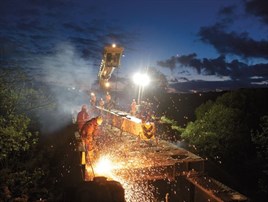 Read the peer reviews for this feature.
Read the peer reviews for this feature.
Debt lies at the heart of the Office of National Statistics’ decision to finally classify Network Rail as a government body.
The national rail infrastructure owner started Control Period 5 (CP5) last April with debt of £31.7 billion. It’s expected to finish CP5 in March 2019 with debt of £49.6bn, having ploughed the difference into the network in the form of renewals and improvements.
Although NR had borrowed from the private sector, it used a government guarantee to ensure it paid a lower interest rate. This guarantee is the Financial Indemnity Mechanism (FIM).
The original idea behind the FIM was that it provided help for NR to establish itself, and would then be phased out. Indeed, in its Final Determination for CP4 (2009-2014), the Office of Rail Regulation (ORR) specifically allowed for NR to raise unsupported debt, but the company decided not to pursue this option.
After many years of discussion, the Office of National Statistics (ONS) decided to reclassify NR following changes to European accounting rules that required it to take account of a government’s exposure to a company’s debt when deciding whether that company should be classed as a government body (see panel). In the UK, government guarantees NR’s debts in full, and this meant that NR must be classed as a government body.
£30.3bn loan programme
Although the change formally took place on September 1 2014, the greatest of the subsequent changes had already taken place. On July 4, Network Rail and the Department for Transport had signed a £30.3bn loan programme to cover NR’s financing needs through Control Period 5.
This deal covers not only what NR directly needs for its tracks and signals, but also covers any debts that need to be repaid or refinanced over the same period, and marks NR’s complete withdrawal from the private finance market for new debt. This runs counter to the view expressed by NR’s Board last February, when it argued that it should be able to retain the ability to raise at least some of its debt on its own.
The loan from government, rather than banks, means that NR will now be using some of the direct grant it receives from DfT to pay the interest it owes DfT for the loan. Ultimately, NR will repay DfT’s debt using some of the DfT grant it receives.
With existing debt continuing to be covered by the FIM and paid back when required, the July deal points towards NR’s finances being rolled into five-year agreements between it and DfT. Such deals could follow ORR’s periodic reviews that set NR’s objectives for the coming five-year Control Period.
These reviews are required to take account of funds available to the DfT and Transport Scotland, and come in the form of Statements of Funds Available (SoFA). The DfT funds England and Wales, while Transport Scotland (TS) covers NR’s network north of the border.
Annual spending settlements
Such a five-year loan settlement could alleviate fears that a return to government control marks a return to the sort of financial control that once exasperated British Rail managers. For example, as BR historian Terry Gourvish recounts in his book British Rail 1974-1997, the state railway’s investment ceiling for 1991/92 was reduced from £1,378 million (equivalent to £2,581m in 2013) to £1,070m, before being eased slightly to £1.095m until the end of 1991, when a further £55m was added.
However, there’s a sting in the tail of a Framework Agreement between NR and DfT (published by the latter on September 1), because it sets the conditions for a return to annual spending settlements. The agreement says: “The Chief Executive - as Network Rail’s Accounting Officer - has the delegated authority to spend up to the amounts allocated to Network Rail each year by the Department in a formal delegations letter.”
DfT in turn can only spend up to limits set by HM Treasury. In this way, government can throttle back on rail spending, should its finances take a turn for the worse.
The process by which DfT and Transport Scotland decide how much they want to spend, and what they want from NR as a result, is called the High Level Output Specification (HLOS). ORR checks this work, while also checking the plans NR produces in response.
This duplication makes it ripe for rationalisation. In deciding how much to spend, the DfT will take a view on how the rail network should develop, including the projects required to deliver it. ORR’s work refines this, and NR refines some more. This could be done bilaterally by DfT/TS and NR, with little or no input from ORR.
Even ORR’s role as overseer of NR’s work could be at risk in the long term. It might hold NR to account, but should the track owner’s plans go awry (for example, if electrification costs go over budget or its deadlines be missed), it will not take long for a Transport Secretary or his senior officials to call in NR’s chairman or chief executive for an explanation.











